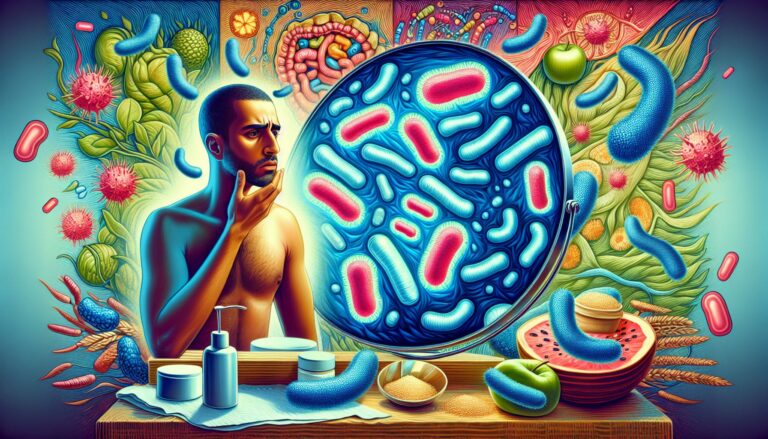Can Spearmint & Peppermint Combat Hormonal Acne?
Can Spearmint & Peppermint Combat Hormonal Acne?
Struggling with hormonal acne can be a frustrating journey, but nature might hold an unexpected solution.
You’ve probably heard of spearmint and peppermint as refreshing flavors in your favorite treats, but these herbs are more than just a burst of freshness. They’re becoming a buzz in the skincare world for their potential to soothe and clear hormonal acne.
Recent studies suggest that spearmint and peppermint could be the gentle warriors your skin needs. Their natural properties are said to balance hormones and reduce inflammation, offering a promising alternative to harsh chemicals.
If you’re curious about harnessing the power of these minty marvels for clearer skin, you’re in the right place.
Well, we’ll be going over:
- What exactly is hormonal acne and why does it affect adults too?
- How do spearmint and peppermint potentially influence hormonal balance and skin health?
- What are the best ways to incorporate these minty herbs into your skincare routine for maximum benefits?
Let’s dive in.

What is hormonal acne?
Hormonal acne isn’t just a teenage issue; adults, especially women, can face it too. It’s when your acne flares up due to hormonal imbalances in your body. This can be due to the menstrual cycle, menopause, or increased androgen levels. These hormonal shifts lead to excess oil production, clogged pores, and ultimately, acne.
You’ll typically find hormonal acne around the jawline, chin, and cheeks. Unlike surface-level blackheads or whiteheads, hormonal acne can manifest as deep, painful cysts. Recognizing the pattern of breakouts can help pinpoint hormonal acne – if your skin acts up around your menstrual cycle, hormones might be the culprit.
Understanding this type of acne is key to finding the right treatment strategy. While over-the-counter products can offer some relief, addressing the hormonal root cause is crucial for long-term improvement. This is where natural remedies, like spearmint and peppermint, step in with their potential hormonal balancing effects.
The causes of hormonal acne
Hormonal acne isn’t just a teenage problem. Adults, especially women, often face this troubling skin condition due to fluctuating hormones. You might be wondering why your skin suddenly breaks out even when you’re far past adolescence. The answer lies in the delicate balance of hormones in your body.
Key hormones like estrogen, progesterone, and testosterone can fluctuate due to various factors, including your menstrual cycle, pregnancy, menopause, or even stress. When these hormones are out of balance, your skin reacts. Androgens, a group of hormones that includes testosterone, can cause the oil glands in your skin to overproduce sebum. This excessive oil can clog pores, leading to the development of acne.
Another culprit behind hormonal acne is the menstrual cycle for women. About a week before menstruation, estrogen and progesterone levels drop, while testosterone levels remain unchanged. This hormonal shift results in higher oil production, which can clog pores and trigger breakouts.
Understanding these causes is crucial in addressing and managing hormonal acne effectively.
The role of hormones in acne
Understanding the role that hormones play in acne development is crucial if you’re looking to address the root cause of those persistent breakouts. Acne, especially the type often referred to as hormonal acne, isn’t just a teenage problem—it’s an issue that can follow you into adulthood, affecting both your skin and your self-esteem.
Hormones such as estrogen, testosterone, and progesterone fluctuate throughout your life and can have a profound impact on your skin. When these hormone levels increase, your skin’s oil glands go into overdrive, producing excess sebum—a natural oil that, in normal amounts, moisturizes your skin. Unfortunately, too much sebum can lead to clogged pores, creating the perfect breeding ground for acne.
This hormonal imbalance is often most noticeable in women during periods of significant hormonal shifts such as puberty, menstruation, pregnancy, and menopause. During these times, you might notice your skin breaking out more than usual, a clear signal that hormones might be playing a role in your acne.
By acknowledging the influence hormones have on acne, you’re better equipped to seek out effective treatments that address not just the symptoms of acne but its hormonal roots as well.
The potential benefits of spearmint and peppermint for hormonal acne
Spearmint and peppermint have gained attention for their potential to manage hormonal acne. Spearmint tea, in particular, is rich in anti-inflammatory properties and contains compounds that may help reduce testosterone levels. Lower testosterone levels can lead to decreased oil production in your skin, reducing the likelihood of clogged pores and breakouts.
Peppermint, while more commonly associated with its refreshing scent and flavor, also holds benefits for skin health. Peppermint oil has strong antibacterial properties, making it a useful tool for fighting the bacteria that can contribute to acne formation. Additionally, its cooling effect can soothe irritated skin, providing relief from the discomfort associated with acne.
By incorporating spearmint or peppermint into your routine—whether through drinking herbal teas or applying topical products—you’re tapping into natural solutions that might help keep your hormonal acne under control. It’s important to do so with guidance from a healthcare provider, especially when considering topical treatments, as essential oils need to be properly diluted to avoid skin irritation.
Studies and research on spearmint and peppermint for treating hormonal acne
Interest in natural remedies for hormonal acne has surged, placing a spotlight on spearmint and peppermint. These herbs have been subject to various studies, aiming to understand their effects on hormonal balance and skin health.
One notable study published in the Journal of Clinical, Cosmetic and Investigational Dermatology explored the impact of spearmint tea on women with hirsutism, a condition often driven by elevated testosterone levels, similar to the underlying causes of hormonal acne. Participants who consumed spearmint tea twice daily saw a significant reduction in testosterone levels over a 30-day period. This finding suggests that spearmint could potentially regulate hormones related to acne.
Peppermint, while less studied for its direct impact on acne, has been recognized for its antibacterial properties. A research article in International Journal of Dermatology highlighted peppermint oil’s effectiveness against acne-causing bacteria like Propionibacterium acnes. The anti-inflammatory and antibacterial nature of peppermint oil could provide dual benefits in managing hormonal acne: reducing skin inflammation and targeting bacterial growth.
It’s essential to approach these findings with a balanced perspective. While promising, more comprehensive studies are necessary to fully understand how spearmint and peppermint can be integrated into acne treatment regimes effectively.
How to incorporate spearmint and peppermint into your skincare routine?
Integrating spearmint and peppermint into your skincare regimen might seem challenging at first, but it’s surprisingly straightforward. Getting started requires understanding the basic ways to utilize these herbs for your advantage.
For oral consumption, spearmint tea is your go-to option. Drinking one to two cups of spearmint tea daily could potentially help balance hormone levels, thus reducing acne outbreaks. Ensure you’re opting for organic tea to avoid pesticides and other chemicals.
If you’re leaning towards topical application, peppermint oil diluted with a carrier oil like jojoba or coconut oil can be directly applied to the skin. This mixture not only harnesses the antibacterial properties of peppermint but also keeps your skin moisturized. A critical piece of advice is to perform a patch test before full application to ensure you don’t have an adverse reaction.
Creating DIY masks and scrubs with peppermint or spearmint essential oils can be an enjoyable way to incorporate these into your skincare. A simple mask can be made using natural yogurt, honey, and a few drops of peppermint or spearmint oil. Apply this concoction once a week for soothing and antibacterial benefits.
Remember, consistency is key when integrating new elements into your skincare routine, especially with natural remedies. Your patience and diligence will pay off as you begin to notice improvements in your skin.
Tips for using spearmint and peppermint for hormonal acne
Incorporating spearmint and peppermint into your acne treatment regimen can be simple and effective. Here’s how to make the most out of these powerful herbs.
Spearmint Tea: Make spearmint tea a daily ritual. Drinking 1-2 cups each day can help balance hormones naturally over time. Opt for organic spearmint leaves for a clean, additive-free brew.
Topical Peppermint: Dilute peppermint oil with a carrier oil such as coconut or jojoba oil. Apply this mixture directly to clean, affected areas. Its cooling effect soothes the skin while its antibacterial properties work to clear acne.
DIY Masks: Combine powdered spearmint or a few drops of peppermint oil with natural ingredients like honey or yogurt to create a homemade face mask. These masks can offer additional moisturizing and antibacterial benefits.
Remember, patience and consistency are crucial as natural remedies may take time to show noticeable effects. Start with small amounts to test your skin’s reaction, and always use sunscreen as some treatments can make your skin more sensitive to sunlight.
Precautions and potential side effects of using spearmint and peppermint for hormonal acne
When incorporating spearmint and peppermint into your skincare routine for hormonal acne, be cautious and aware of potential side effects. Both herbs are generally safe for most people, yet they can cause reactions in sensitive individuals.
Spearmint, if consumed in large amounts, may lead to gastrointestinal issues such as nausea or diarrhea. Its estrogen-lowering effects could also potentially affect menstrual cycles or fertility in women when not consumed in moderation.
Peppermint oil, particularly when used topically, can cause skin irritation or an allergic reaction in some individuals. It’s vital to always dilute essential oils with a carrier oil before application to avoid redness, itching, or burning sensations. Doing a patch test on a small skin area 24 hours before full application is a wise move to prevent unexpected allergic reactions.
Bear in mind that any natural remedy should complement, not replace, advice from healthcare professionals. If you’re currently on medication or have underlying health conditions, consulting with a doctor before adding spearmint or peppermint to your regime for acne treatment is crucial.
Conclusion
Navigating the complex world of hormonal acne can be challenging but incorporating natural remedies like spearmint and peppermint into your skincare routine might offer a ray of hope. Whether you’re sipping on spearmint tea to balance your hormones or applying diluted peppermint oil to target acne-causing bacteria, these natural solutions have shown promising results.
Remember consistency is your ally in the fight against hormonal acne. However, it’s crucial to listen to your body and be mindful of any potential side effects. Always consult with a healthcare professional before making significant changes to your skincare or health regimen.
With the right approach and a bit of patience, you could see a noticeable improvement in your skin’s condition.






